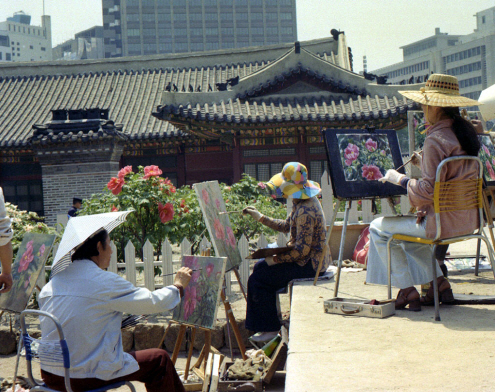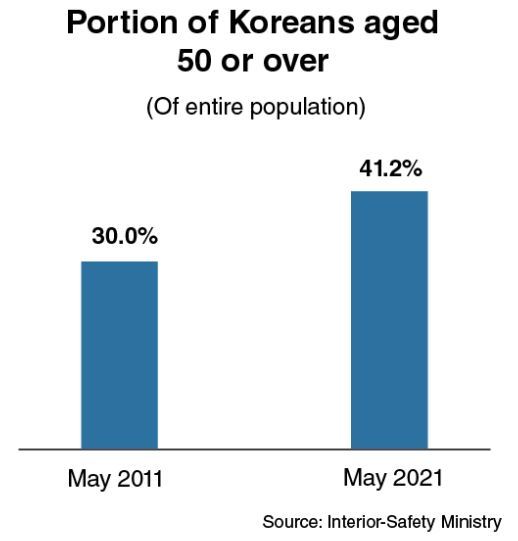[News Focus] Korean population extends losses for 18 consecutive months
Portion of over-50s up 11 percentage points in a decade
By Kim Yon-sePublished : June 3, 2021 - 14:42

SEJONG -- South Korea’s population retreated to 2016 levels as of last month, with the demographic figure posting unprecedented negative growth over the past 1 1/2 years.
According to the Ministry of Interior and Safety, the nation’s population fell by 19,075 (8,685 for men and 10,390 for women) from 51.702 million in April to 51.683 million in May. It was at its lowest since October 2016 when the figure was 51.677 million.
After peaking at 51.851 million in November 2019 -- which could possibly remain the all-time high in Korean history including the coming decades -- the figure continued to drop for the 18th consecutive month starting from December 2019, during which the population lost 168,402 in less than two years.
The negative demographic growth, due to deaths outnumbering births across the nation, was unprecedented.

In May, Seoul took the lead in the decline as the number of residents fell by 13,356 on-month. The capital’s population dropped to the level to that of the mid-1980s to stay at 9.57 million.
Alongside the low birthrates, the sharp drop could be somewhat attributed to the ongoing influx of Seoul citizens to Gyeonggi’s new residential towns, built in accordance with government housing supply policies.
Daegu placed second with a slide of 3,356 to 2.4 million, followed by Busan down 2,370 to 3.36 million. South Gyeongsang Province shed 2,325, North Gyeongsang Province 2,304, South Jeolla Province 1,725 and North Jeolla Province 1,649.
Among the next on the list were Gwangju, whose population decreased by 1,633, Ulsan by 988, Gangwon Province by 684 and Daejeon by 458.
Deaths outnumbered births nationwide last month by 24,627 vs. 21,907 -- a reversal of the situation in past decades. While the nationwide gap between deaths and births stood at 2,720, other factors pushed the population decrease to 19,075 people in May.
The factors included the tally for foreigners, the long-term residency status of Koreans overseas and foreign nationals here, or citizenship changes (Koreans renouncing their citizenship and foreigners acquiring Korean citizenship).
Deaths -- which started to outstrip births in November 2019 in terms of tally -- outnumbered the latter for 17 of the 18 months during the November 2019-May 2021 period, except for in September 2020.
Relative to the population as a whole, the proportion of people under the age of 15 posted an all-time low of 12 percent last month. Youths made up 13.5 percent of the total population five years earlier in May 2016 and 15.7 percent a decade earlier in May 2011.
On the contrary, the elderly population -- those aged 65 or over -- sharply climbed from 11 percent of the total in May 2011 to 13.5 percent in May 2016 and reached a record high of 16.7 percent in May 2021.
Last month, 41.2 percent of the population, or 21.3 million people, were aged 50 or over. The number of octogenarians, nonagenarians and centenarians hit 1.77 million, 255,247 and 11,062, respectively. The portion of those aged 50 and above surged by more than 10 percentage points in 10 years from only 30 percent (15.2 million of then-population of 50.6 million) in May 2011.
Among all age groups, those in their 50s made up the highest percentage of the total at 8.6 million. In contrast, there were only 3.87 million children under 10 and 4.74 million young people aged between 10-19.
Further, people in their 60s at 6.95 million outnumbered those in their 30s at 6.78 million and those in their 20s at 6.75 million.
Data from the Interior Ministry also showed that Korea, an aged society by United Nations’ standards, saw the people’s average age reach a historic high of 43.4 (42.3 for men and 44.5 for women).
This contrasted with the average ages of 40.7 in May 2016 and 38.4 in May 2011.
By Kim Yon-se (kys@heraldcorp.com)




![[KH Explains] No more 'Michael' at Kakao Games](http://res.heraldm.com/phpwas/restmb_idxmake.php?idx=644&simg=/content/image/2024/04/28/20240428050183_0.jpg&u=20240428180321)




![[Grace Kao] Hybe vs. Ador: Inspiration, imitation and plagiarism](http://res.heraldm.com/phpwas/restmb_idxmake.php?idx=644&simg=/content/image/2024/04/28/20240428050220_0.jpg&u=)








